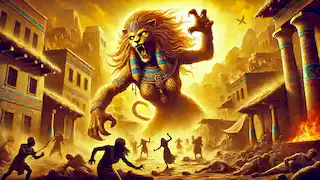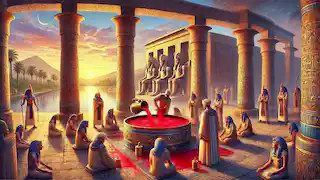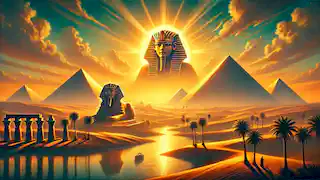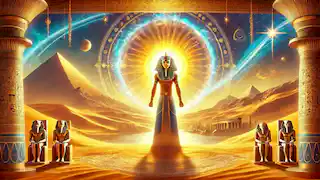In the beginning, before time itself was measured, before the mountains, the rivers, and the sands of the vast desert were formed, there existed only Nu, the swirling, endless chaos of the primordial ocean. This boundless sea was without shape, without direction, a void of pure potential. But from this nothingness arose the great god Ra, born of the waters, a being of such radiant light that his mere presence divided the darkness and brought the first spark of creation into existence.
Ra stood alone in this nascent universe, a figure of immense power and majesty. His crown gleamed with the disk of the sun, and his body shimmered with the light of a thousand stars. From the very first moment of his emergence, Ra knew his purpose: to shape the world, to bring order to the chaos, and to fill the void with life.
As Ra opened his mouth and spoke the first word, the elements obeyed his command. The waters of Nu receded, and the Earth began to take form beneath his feet. He raised his hands to the sky, and the heavens were lifted high above, separating themselves from the ground below. With his divine breath, Ra summoned the wind, which rushed across the land, giving movement to the still air. He placed his right eye in the sky, and it became the sun, shining brightly over the world, casting away the darkness and filling the land with warmth and light. His left eye he placed in the night sky, and it became the moon, watching over the world in the hours of darkness.
But Ra’s creation was far from complete. The world was still a barren place, devoid of life, waiting for the touch of the divine to bring it to fruition. To aid him in this monumental task, Ra created Shu, the god of air, and Tefnut, the goddess of moisture, from his own body. Shu was tasked with lifting the sky and keeping it high above the Earth, while Tefnut spread her waters across the land, nurturing the soil and preparing it for the life to come.
Together, Shu and Tefnut worked tirelessly under Ra’s watchful gaze. Shu held the sky aloft, keeping it separate from the Earth, while Tefnut’s waters nourished the barren land. Ra watched with satisfaction as the elements began to take their proper places, and the world slowly came into being.
The next task was to create the land itself. Ra called forth Geb, the god of the Earth, and Nut, the goddess of the sky. Geb was strong and sturdy, his body forming the mountains and valleys, while Nut was graceful and expansive, her starry body arching across the heavens. Ra decreed that Geb and Nut should be separated, so that the sky and Earth would remain apart. Nut stretched herself over the heavens, her body forming a canopy of stars, while Geb lay below, his body becoming the soil, the rocks, and the fertile plains of the Earth.
As Ra surveyed the world he had created, he saw that it was good, but it was still incomplete. The Earth needed life to fill its vast expanse. So Ra wept, and from his tears, the first humans were born. These men and women, made from the tears of the great god, were given the fertile land of Kemet, which would one day be known as Egypt. Ra taught them the secrets of farming, the arts of building, and the ways of worship, so that they might thrive and live in harmony with the world he had created.
But Ra’s work was not without opposition. From the depths of the underworld arose Apep, the great serpent of chaos, who sought to undo all that Ra had created. Apep was a creature of darkness and destruction, a being whose sole purpose was to devour the sun and plunge the world back into the endless night of the primordial ocean.
Every night, as Ra descended into the Duat—the realm of the dead—Apep would rise to challenge him. The serpent would coil around Ra’s solar barque, attempting to swallow the sun and bring about eternal darkness. But Ra, ever vigilant, was not alone in this nightly battle. He was accompanied by a host of gods and goddesses who stood by his side, ready to defend the sun and ensure that it rose again each morning.

Among Ra’s loyal protectors were Bastet, the fierce lioness goddess who guarded him with her claws and teeth, and Sekhmet, the warrior goddess whose wrath was as fierce as the desert sun. Together, they fought against Apep’s attacks, fending off the serpent’s advances and ensuring that the world remained in balance.
Each night, the battle raged as Ra’s barque sailed through the underworld, passing through the twelve gates of the Duat. At each gate, Ra was met with challenges and obstacles, but with the aid of his divine companions, he overcame them all. As the first light of dawn broke over the horizon, Ra would emerge victorious, and the sun would rise once more, a symbol of the god’s enduring power and the triumph of order over chaos.
But Ra’s challenges did not end with the defeat of Apep. As the years passed, Ra began to feel the weight of his responsibilities. His once-glorious reign over the world was not as it had been in the early days of creation. The humans, whom he had created from his own tears, began to forget the reverence they once had for their creator. They grew prideful and independent, turning away from Ra’s teachings and neglecting the rituals that honored him.
Ra, feeling betrayed by the very beings he had brought to life, grew angry. He decided that the time had come to remind the humans of his power and to punish them for their ingratitude. Summoning Sekhmet, the goddess of war and destruction, Ra commanded her to unleash her fury upon the Earth and to bring the humans back into submission.
Sekhmet, ever eager for battle, descended upon the land like a raging storm. Her eyes burned with the fire of the sun, and her claws were sharp as blades. She tore through villages and cities, leaving a path of destruction in her wake. No one could stand against her wrath, and the humans, who had once forgotten their god, now cowered in fear before Sekhmet’s might.

For days and nights, Sekhmet’s rampage continued. The rivers ran red with the blood of the slain, and the once-prosperous lands of Kemet lay in ruins. Ra watched from the heavens, his anger slowly giving way to regret. He had wanted to teach the humans a lesson, but now he feared that Sekhmet would destroy them all and leave nothing but desolation in her wake.
Realizing that he needed to stop Sekhmet before it was too late, Ra devised a plan. He ordered his priests to brew a vast quantity of beer and mix it with red ochre to resemble blood. When Sekhmet saw the great lakes of what she believed to be blood, she drank deeply, her thirst for violence temporarily sated. But the beer was potent, and as Sekhmet drank more and more, she became intoxicated. Her rage subsided, and she eventually fell into a deep slumber.
When Sekhmet awoke, her bloodlust had been quelled, and she returned to Ra’s side, no longer driven by her thirst for destruction. Ra, relieved that the world had been spared, decided to withdraw from his active rule over the Earth. He ascended to the heavens, where he would remain as the sun, distant yet ever-present, watching over the world from afar.
Though Ra no longer walked among the mortals, his presence was still felt in every sunrise and sunset. The people of Egypt continued to honor him as the supreme god, knowing that it was by his light and power that they were sustained. Ra’s temples and shrines dotted the landscape, from the grand pyramids of Giza to the sacred temple of Karnak. His name was inscribed on the walls of tombs, and his story was passed down through generations, becoming a central part of Egypt’s rich mythological heritage.

As the centuries passed, however, the world began to change. New gods and goddesses rose to prominence, and Ra’s role as the supreme deity was challenged. The people of Egypt began to turn their worship toward other gods, such as Osiris, the lord of the underworld, and Isis, the goddess of magic and motherhood. These gods, with their tales of resurrection and power over death, captivated the hearts and minds of the people, and Ra’s influence began to wane.
Yet Ra did not disappear from the pantheon. He remained a central figure in the religion of ancient Egypt, even as new myths and stories emerged. Ra’s story became intertwined with those of the other gods, and his role as the creator and protector of the world remained a vital part of Egypt’s spiritual tradition.
But Ra’s influence was not limited to the realm of the gods. His legacy was also felt in the daily lives of the people. Every morning, as the sun rose over the horizon, the people of Egypt were reminded of Ra’s power and presence. The sun’s warmth and light were a constant source of life and sustenance, allowing crops to grow and providing the energy needed for daily activities. Ra’s journey across the sky each day became a symbol of the cycle of life, death, and rebirth—a reminder that even in the darkest times, the light of the sun would always return.
As Ra gazed down upon the Earth from his celestial throne, he saw the rise and fall of dynasties, the ebb and flow of the Nile, and the changing fortunes of the people he had created. He no longer intervened directly in their affairs, but he was always there, watching
over them from the heavens, ensuring that the balance between order and chaos was maintained.

In the later years of his reign, Ra’s power began to diminish. The people of Egypt, once so devoted to him, began to lose faith as new political powers arose, and foreign invaders brought their own gods and traditions to the land of Kemet. Yet Ra remained a fixture of the divine order, an ever-present force in the pantheon of Egyptian gods.
Ra’s legacy became immortalized not just in the temples and tombs of Egypt but in the very fabric of the cosmos. He was the light that touched the pyramids of Giza, the golden glow that illuminated the great temples of Karnak, and the radiant force that fueled the life of all beings. Though his role shifted over time, Ra’s story was never forgotten. He remained a symbol of creation, power, and the eternal cycle of the sun.
As Ra’s influence faded, the world continued to change, but the people never completely abandoned their reverence for him. In times of great peril, they looked to the sky, where Ra’s sun still burned brightly. And in their hearts, they carried the knowledge that Ra had given them life, order, and the very fabric of their world. His presence was eternal, a light that could never be extinguished, guiding them through both the days of prosperity and the nights of despair.
Even as new dynasties arose and fell, and Egypt itself was reshaped by the hands of history, Ra remained a fixture in the spiritual consciousness of the people. His name, once spoken with reverence in every corner of the land, was passed down through the generations, a reminder of the god who had brought light into the darkness and order to the chaos.

And so, the tale of Ra continues to be told, as timeless and enduring as the cycle of day and night. From the earliest days of creation to the modern era, Ra’s story remains a central part of Egypt’s rich cultural heritage. His legacy lives on in the art, architecture, and religious traditions of the land he shaped, a testament to the power of creation and the enduring strength of the sun.
Ra’s light, though distant, still shines upon the Earth, and his story, like the sun itself, is eternal—a flame that will never be extinguished, forever illuminating the world he created.


















